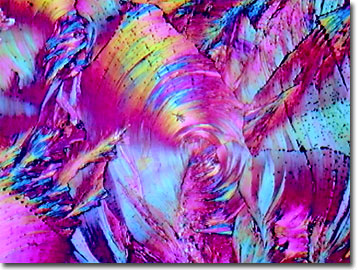Polarized Light Digital Image Gallery
Oleic Acid
Olive oil, the elixir at the foundation of Mediterranean civilizations, features from 55 to 85 percent oleic acid and about 9 percent linoleic acid as component fatty acids. The health and therapeutic benefits of olive oil have long been appreciated as evidenced by Hippocrates, the father of medicine, singing its praises. Unlike dietary fat perceived as bad for health, oleic acid is a monosaturated fat believed to help reduce serum cholesterol levels and low-density lipoproteins or LDLs ("bad" cholesterol), while not affecting levels of high-density lipoproteins or HDLs ("good" cholesterol).

View a second image of oleic acid.
With 18 carbons, 34 hydrogens, and two oxygen atoms, oleic acid, a straight-chained aliphatic organic compound, is also known as cis-9-octadecenoic acid, emersol 220, glycon, and metaupon. Oleic acid is a clear, colorless liquid with a molecular weight of 282.52, a melting point of 16.3 degrees Celsius, a boiling point of 286 degrees Celsius, and a flash point of 189 degrees Celsius. Although this fatty acid is insoluble in water, it is very soluble in ethanol and other organic solvents. Optically, the refractive index of pure oleic acid is 1.4582. As a fatty acid, oleic acid molecules feature a hydrophobic ("water fearing") tail and a hydrophilic ("water loving") head, important in how the molecule interacts with cell membrane lipids.
Known also as red oil, oleic acid is used as a chemical surfactant in industrial chemical processes and in textile manufacturing, and as an emulsifier in foods and cosmetics. For rubber production, oleic acid acts as an activator and an accelerator, and when extracted from soybeans, may contribute to future sources of biodiesel fuel. In addition to olives, canola (rapeseed), soybeans, cod-liver, coconut, and almond oils are naturally high in beneficial oleic acid. Genetically-engineered soybean cultivars are now boasting 80 to 90 percent oleic acid content compared to the 15 to 20 percent found in conventional soybeans.
Contributing Authors
Omar Alvarado, Thomas J. Fellers and Michael W. Davidson - National High Magnetic Field Laboratory, 1800 East Paul Dirac Dr., The Florida State University, Tallahassee, Florida, 32310.
BACK TO THE POLARIZED LIGHT IMAGE GALLERY
BACK TO THE DIGITAL IMAGE GALLERIES
Questions or comments? Send us an email.
© 1995-2025 by Michael W. Davidson and The Florida State University. All Rights Reserved. No images, graphics, software, scripts, or applets may be reproduced or used in any manner without permission from the copyright holders. Use of this website means you agree to all of the Legal Terms and Conditions set forth by the owners.
This website is maintained by our
Graphics & Web Programming Team
in collaboration with Optical Microscopy at the
National High Magnetic Field Laboratory.
Last Modification Friday, Nov 13, 2015 at 01:19 PM
Access Count Since September 17, 2002: 15445
Visit the website of our partner in introductory microscopy education:
|
|
